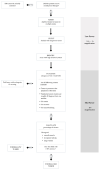Tumor Stroma Ratio and Its Significance in Locally Advanced Colorectal Cancer
- PMID: 35621653
- PMCID: PMC9139914
- DOI: 10.3390/curroncol29050263
Tumor Stroma Ratio and Its Significance in Locally Advanced Colorectal Cancer
Abstract
Colorectal cancer is the third leading cause of cancer-related death, and its incidence is rising in the younger patient population. In the past decade, research has unveiled several processes (underlying tumorigenesis, many of which involve interactions between tumor cells and the surrounding tissue or tumor microenvironment (TME). Interactions between components of the TME are mediated at a sub-microscopic level. However, the endpoint of those interactions results in morphologic changes which can be readily assessed at microscopic examination of biopsy and resection specimens. Among these morphologic changes, alteration to the tumor stroma is a new, important determinant of colorectal cancer progression. Different methodologies to estimate the proportion of tumor stroma relative to tumor cells, or tumor stroma ratio (TSR), have been developed. Subsequent validation has supported the prognostic value, reproducibility and feasibility of TSR in various subgroups of colorectal cancer. In this manuscript, we review the literature surrounding TME in colorectal cancer, with a focus on tumor stroma ratio.
Keywords: colorectal cancer; immune cells; tumor budding; tumor microenvironment; tumor stroma ratio.
Conflict of interest statement
The authors declare no conflict of interest.
Figures


References
-
- Lea D., Haland S., Hagland H.R., Soreide K. Accuracy of TNM staging in colorectal cancer: A review of current culprits, the modern role of morphology and stepping-stones for improvements in the molecular era. Scand. J. Gastroenterol. 2014;49:1153–1163. doi: 10.3109/00365521.2014.950692. - DOI - PubMed
-
- Atiya H., Frisbie L., Pressimone C., Coffman L. Mesenchymal Stem Cells in the Tumor Microenvironment. Adv. Exp. Med. Biol. 2020;1234:31–42. - PubMed
-
- Hynes S.O., Coleman H.G., Kelly P.J., Irwin S., O’Neill R.F., Gray R.T., McGready C., Dunne P.D., McQuaid S., James J.A., et al. Back to the future: Routine morphological assessment of the tumour microenvironment is prognostic in stage II/III colon cancer in a large population-based study. Histopathology. 2017;71:12–26. doi: 10.1111/his.13181. - DOI - PubMed
Publication types
MeSH terms
LinkOut - more resources
Full Text Sources
Medical
Miscellaneous

